Are you looking for a contractor?
Submit our quick form and get quotes now!
Table of Contents
7 min read
Urban Garden: Growing a Green City-Based Oasis
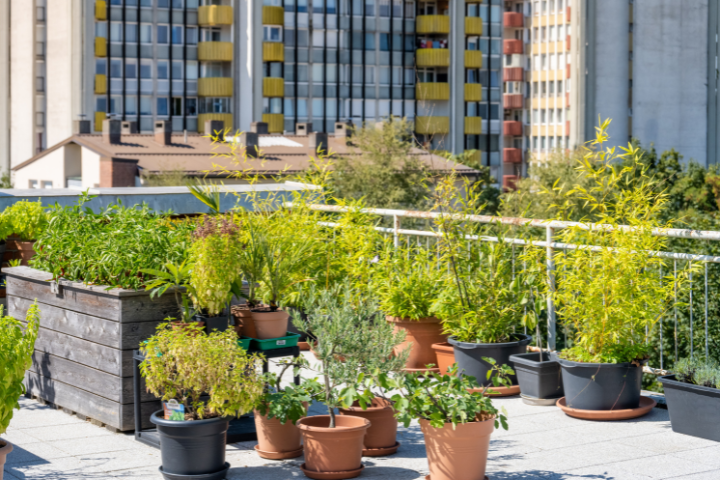

7 min read
Urban Garden: Growing a Green City-Based Oasis
Exterior renovationsUrban Garden: Growing a Green City-Based Oasis
An urban garden serves as a way to benefit from healthy greens right in the city. Experience growing greens in your tiny backyard and take pride in this new source of inspiration. It’s a genuine, lush asset to add to your landscaping. However, it’s not as easy peasy lemon squeezy as you might think. Between crop insect pests and urban pollution, here’s the must-have information to keep in mind before throwing yourself, hands deep, into this dirt-filled adventure.
The Basis of an Urban Garden
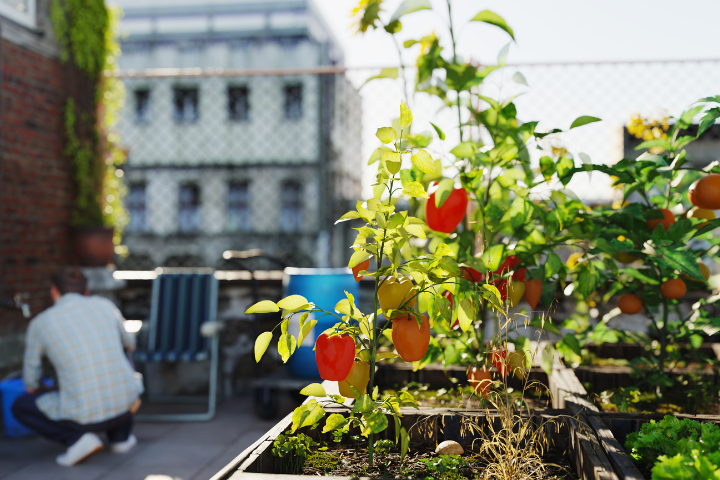
Why grow a vegetable garden in the city?
To benefit from the best of both worlds:
Countryside garden
City resources
Urban agriculture guarantees organic vegetables, or at the very least, greens on which you know exactly what was sprayed. Furthermore, growing an urban garden has a few environmental benefits, amongst which are the following:
Climate regulation
Carbon capture
Water regulation
Environmental education
Food security
Add more
And, the most important of them all is yet to come. Plants largely contribute to temperature control in urban environments prone to what's commonly known as “urban heat islands.” Whether it’s an urban garden or potted greens, each and every initiative matters.
When Potting Soil Is Polluted
This is about contaminated or polluted potting soil, which is completely different than polluted air. However, in both cases, note that the chosen urban agriculture model directly impacts your risks of being exposed to certain pollutants.
While indoor urban agriculture strongly limits the risks of exposing plants to pollution, it’s still not always an appealing option for gardeners.
When deciding on growing an urban garden, you have to pay special attention to where you decide to plant your crops. Should you choose soil-grown instead of container-grown, inquire with your neighbourhood and city hall to know how the land parcel was used for decades prior. For example, the soil might be contaminated with lead.
The First Steps to Urban Gardening
Balconies, Roofs, Decks, or Backyard: Find the Ideal Spot
We just provided you with an overview of the importance of where your garden is grown and the type of crops used based on your situation. Now, the chosen location will most often be the one you already own.
If you already own a plot of land in the city centre, it’s likely there that you’ll seek to grow your fruits and veggies. Likewise, if you only have a balcony or access to a rooftop.
However, no matter the available spot, 6 hours of sunshine a day is the least you need to successfully grow anything. Make sure of it before investing.
Now then, what do you need to start your urban crop-growing adventure?
Basic Equipment to Jumpstart Your Garden
Potting soil
Containers, pots, or planters
Plant saucers
Plants or seeds
Blade
Hand trowel
Garden hose
How to Make an Urban Garden: Planning and Executing
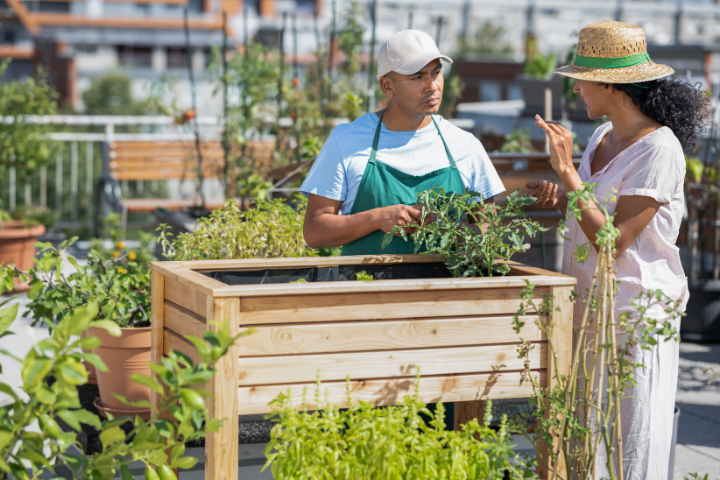
Crop Selection
Whether your urban garden is grown in your apartment, on your deck, or on a small plot of land as a part of your local community garden, you risk needing to adapt your crops based on the surrounding pollution. Your choice of fruits and vegetables may be dependent on the quality of the soil, provided that you don’t replace the existing soil with organic potting soil. Should you proceed as such, make sure the potential pollution source is no longer present.
If you decide to opt for potted crops, the soil used will be of high quality since you can choose to use organic soil purchased from your local nursery.
Design and Layout
The key to a successful urban garden lies in its layout. What a shame it would be if wrongfully positioned plants would deprive you of delighting in your harvest.
Here are a few tips and tricks for designing the ideal garden.
Optimized Small Urban Garden Design
The secret to cultivating crops in small spaces lies in a gardening technique called intercropping. It consists of planting a new, slow-growing crop in the same row as a fast-growing vegetable. For example, in spring, you can seed summer romaine lettuce between rows of artichokes.
However, intercropping over a great distance can impede the whole of your garden crops. As such, you must find an even middle between the space available and the amount of space covered in crops. The goal is to have a global production of two different vegetables slightly higher than that expected should you have only planted one vegetable during the season.
Urban Permaculture Pointers
You can easily find online a guide detailing all the pointers to implement when engaging in urban permaculture practices. So, for good measure, here are a few:
Make your own seeds (avoid using F1 seeds)
Embrace vertical farming practices (pole beans, peas, herbs, etc.)
Benefit from composting (fruit and vegetable peels, etc.)
Focus on high-yielding vegetables over small areas
Radish, carrots, spinach, lettuce, or pole beans are perfect to mass produce over a small patch of soil. Whether you own a ground-growing or a potted garden, prioritize such crops.
Maximize Production with Crop Rotation
You’re not going to invest in new potting soil bags every year. Once installed, your urban garden will remain in its spot, summer through winter. To allow the soil to regenerate, you should practice crop rotations.
Not all plants consume the same substances, nor will they use the soil evenly. As such, to make it through, plan a rotation schedule between the following crops:
1st pot: root vegetables (beets, radish, carrots)
2nd pot: fruits and bulbs (tomatoes, winter squash, garlic, shallots)
3rd pot: leafy vegetables (lettuce, spinach, cabbage)
4th pot: Legumes (mustard, beans, peas)
Rotate your crops every year. That way, you’re giving the soil a break, optimizing productivity.
Potted Plants vs. In-Ground Garden: Handy Tips
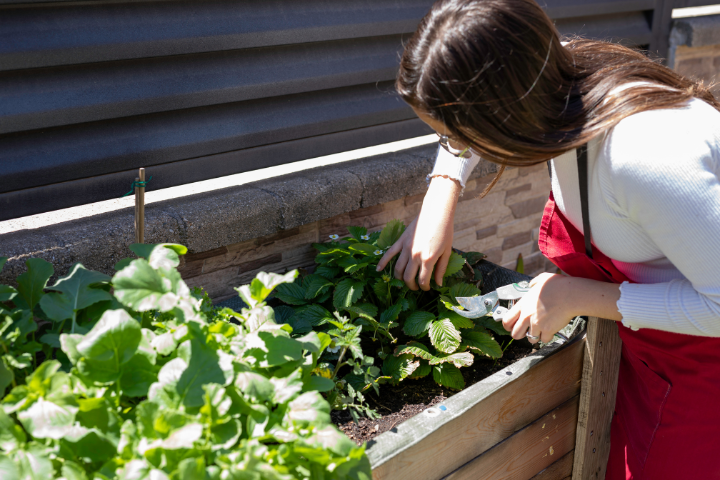
Potted Crops and Raised Bed Garden
You can grow anything in a pot. Your only obstacle is the size of your containers. Some vegetables grow fast. To accommodate your plants, you’ll need to get large pots or prepare yourself to transplant crops, one after the other.
Tip 1: Base the size of your pot with that of the vegetable
Tip 2: Choose a pot based on the crop’s growing speed
Tip 3: Choose a pot based on the depth of the roots
Tip 4: Fertilize as need be
Manage Water and Nutrients for Healthy Plants
In urban areas, your choice is limited to tap water or rainwater. However, between those two options, tap water is definitely the best.
As a matter of fact, rainwater has two drawbacks:
Contains pollutants from rooftops
Must be stored
And, note that installing a rainwater cistern might not be the best idea when living in the city. Keep it simple and use tap water to water your urban garden.
Prevent and Treat Diseases and Parasites
The first rule of order is as follows: Avoid needlessly harming your plants.
To prevent diseases from developing, stop ripping off your plants’ stem suckers.
Indeed, suckers draw on a part of the plant’s energy, leading to the growth of smaller fruits. However, when you prune the suckers, you’re hurting the stem. From this injury, diseases and fungi attack the plant.
The second rule to follow is as such: Avoid watering the plant's leaves.
When watering the leaves, the latter stores moisture for a long time, which promotes fungi growth already found on the plant: mildew and odium. Ineffective watering can negatively affect your harvest.
To protect your rooftop crops or balcony-grown plants from insects, make sure to have mulch or insect-proof netting in place.
Urban Gardening and Ecology: Challenges and Solutions
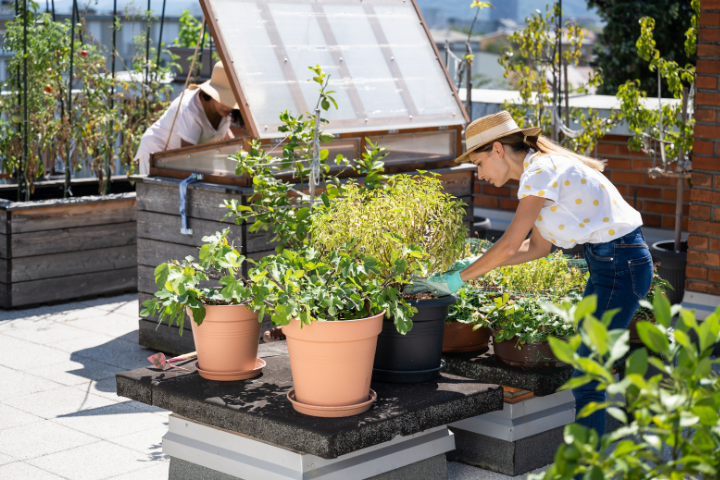
Manage City-Specific Climate
Here’s an in-depth look at the different climates you may experience in your city:
Higher temperatures (evening through nightfall)
Thermal breeze
Urban pollution
All these factors can directly impact urban agriculture, but ultimately rest on the number of factors that can alter the microclimate specific to your neighbourhood or even your street:
Coastal vs mountain-valley
Clear sky or overcast
Height of buildings
Modern or old façades
Wide or narrow street
And more
To effectively manage the unmanageable—climate—get yourself a thermometer, moisture sensor, rain gauge, or anemometer. By fitting your urban garden with such equipment, you’ll be able to meet climate requirements specific to your area of residence.
Adopting Eco-Friendly Gardening Methods
Crop rotation, intercropping, composting, and not pruning suckers are all techniques you can use to tend to your garden in an eco-friendly way.
Furthermore, on such small surfaces, you can handpick weeds or aphids from your plants. Eco-friendly gardening is especially tailored to urban gardening.
If you are, or plan on, growing crops in-ground, take advantage of intercropping to ward off pests, like pairing flax with potatoes to repel Colorado potato beetles.
Get quotes for your exterior renovation or landscaping project
RenoQuotes.com can help you get quotes for your exterior renovation project. If you submit your project to us, we’ll put you in contact with top-rated contractors. Fill in the form on the homepage (it only takes a few minutes), and you will receive quotes from companies that are specialized in home renovations.
Dial 1-844 828-1588 to speak with one of our customer service representatives.
Last modified 2024-01-29
Looking for something else?
Related articles
The latest industry news, interviews, technologies, and resources.
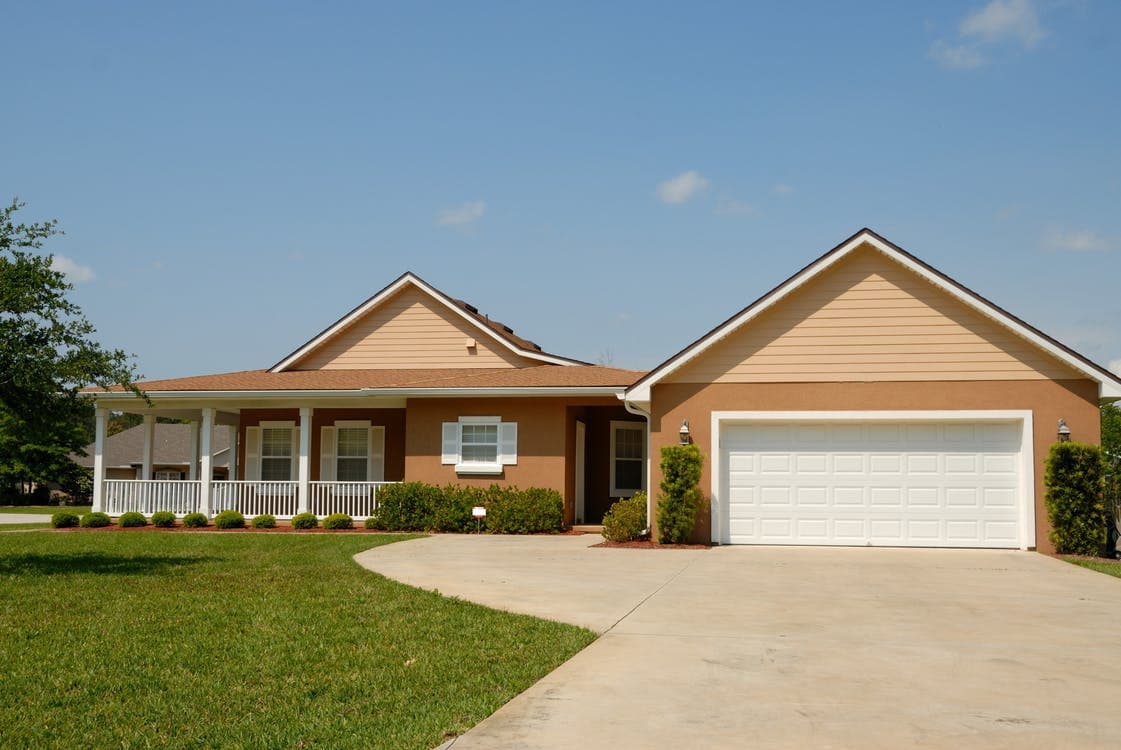
N/A • 07 Nov 2023
Much more spacious than the shed, the garage is a privileged place to store an impressive quantity of goods, while ensuring your family vehicle safe storage.

SoumissionRenovation.ca • 07 Nov 2023
It’s no secret that over the past few years, green construction has grown in popularity and for good reason! An ecological home is trendy due to its green efficiency, its lack of carbon footprint as well as its eco-friendly capabilities.

N/A • 07 Nov 2023
Whether by choice or simply to minimize costs, living in a small house or small apartment has both its advantages and disadvantages. However, it’s not impossible for you to arrange things to suit both aesthetic and practical needs.

RenoQuotes.com • 08 Apr 2024
If you've been meditating on a renovation project for a while, but haven't been too sure about ways to jump start it, then you've come to the right place! RenoQuotes.com is here to make that renovation project you've been dreaming about moving forward finally, and might we add, effortlessly. So maybe you've never heard of us? No worries! Here's a breakdown of our mission, our service and the role we hope to play in your upcoming renovation project!
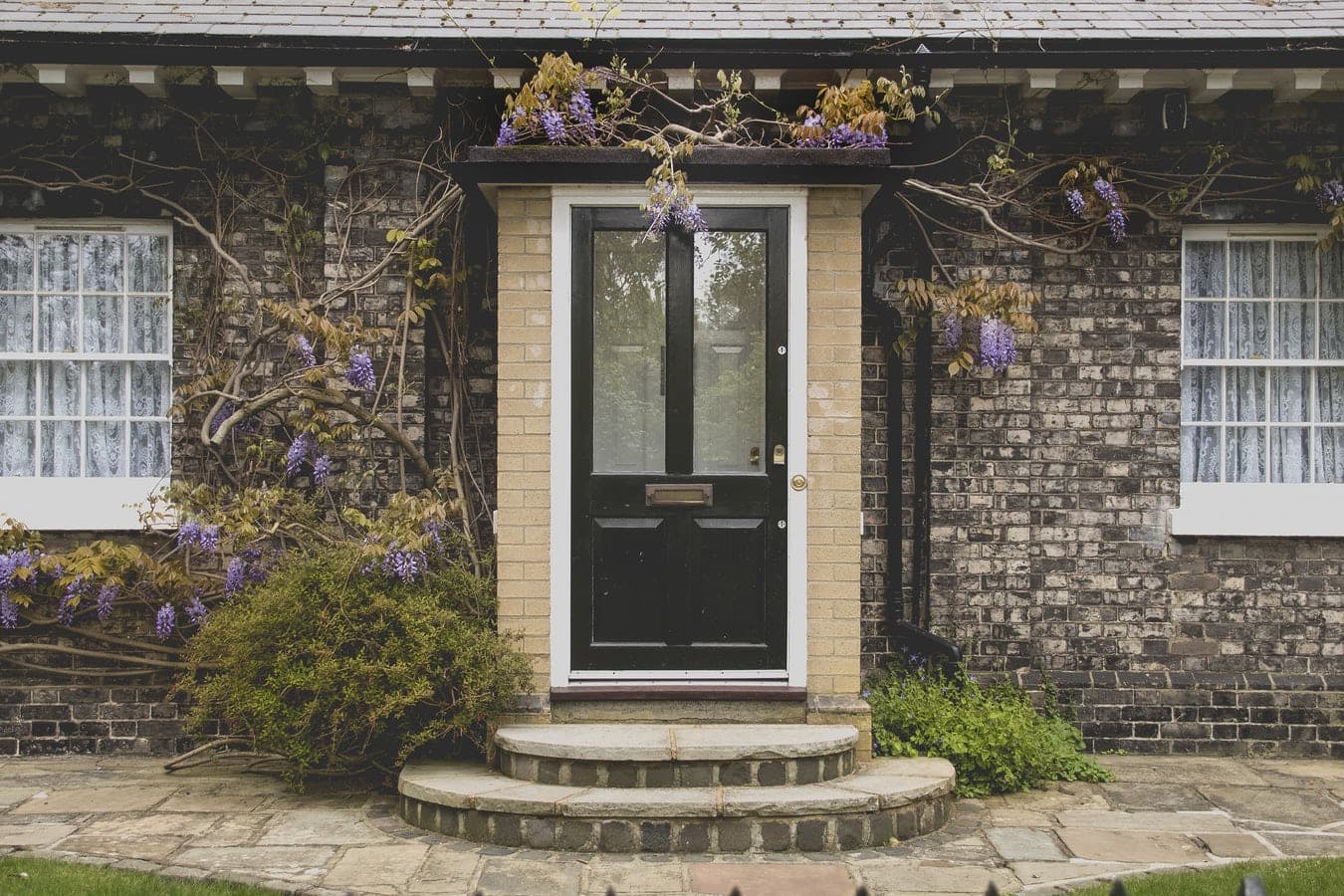
Léa Plourde-Archer • 07 Nov 2023
Doors and windows are often regrouped in the same category as they both represent creating openings towards the outside. They are a part of the décor but are also essential elements in terms of the home's water and airtightness, as well as the amount of natural light that enters. We have gathered here all of our articles about doors and windows, as well as several elements associated with them: